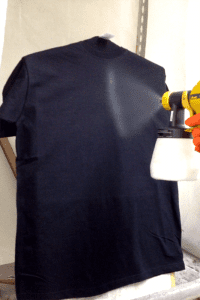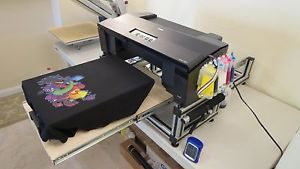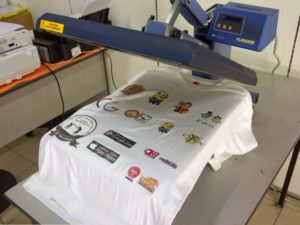The Direct to Garment Printing Process May 12, 2018 – Posted in: dtg printer
The Direct to Garment Printing Process… A Brief Overview
First Off, What is DTG Printing?
In 2004, the apparel industry was taken by storm with the onset of the first commercial based direct-to-garment (DTG) printers. DTG printing simply refers to the process of directly printing onto clothes, caps, bags, home furnishings and more. Inkjet technology is used to get things done in DTG printing.
The reason why individuals and small business owners are giving so much emphasis on this particular method is not that hard to find. Inkjet DTG printing is faster, economical and definitely much cleaner than any other traditional printing methods. For businesses, this method curtails much of the start-up costs and surely takes less space than other types of printing machines.
Designers can easily create designs, and then produce great things in a huge quantity. There is no restriction on the use of colors, and there is no time spent in adjusting the screen of the machine. In order to improve the productivity, DTG solution can be paired with an automatic pre-treatment machine. Printers that have the job of producing huge volumes with many machines can think of investing in a tunnel dryer. This would definitely result in a soft handling of the print.
Why Has DTG Printing Become so Popular?
Previously, putting a custom design on a cotton t-shirt or bag would require the use of digital transfer paper (heat transfer) or screen printing. Both aforementioned methods have their advantages, but their extensive disadvantages have contributed to the thought of moving towards DTG printing.
So, What’s the DTG Printing Process?
Even though DTG printing machines all differ slightly, there are still only 3 basic steps in the printing process… it’s a simply process really:
- Pretreat – basically prepping your products (t-shirts, bags, etc.) for printing.
- Load – properly place your products in each platen.
- Print – let the printer do its thing.
… then sell (Step 4), but that’s on you; not the printing machine.
The simplified process described above obviously assumes that you have graphics ready, and that you’re ready to print.
Breaking Down the Full Process
- Pretreat (for print white ink only)
Pretreatment is basically a primer that you add to your garments. This requires a hand-sprayer or automatic machine to apply a light coat of pretreatment. For print color ink, pretreating your garments is NOT essential, for print white ink it definitely helps produce a crisper image and helps with the wash-ablilty of the garment.

- Prepping your Graphics
All DTG printing usually begins at a computer. All DTG machine need clear, clean artwork to produce the best image on your garments. Graphics can be created in any number of software programs like Adobe Photoshop, Adobe Illustrator or CorelDRAW. Just remember to create your original image in as a high resolution graphic.
A good suggestion is to print out your graphic on paper at the same size you plan to print it on your garment… if it looks good on paper at that size, then it will look good on your garment.
- Loading and Printing
Once you’ve placed your garments on the platens for printing, you’ll need to send your image to the printer. Your DTG printer will come with specialized software that translates your image into a raster image allowing your printer to produce the printed output.


- Curing
Just like in traditional screen printing, you will need to cure the ink from your DTG printer. This generally requires 2-3 minutes at 340 degrees F. Curing the ink allows the ink to truly set, and increases the wash-ability of your garments.


Let’s jot down the pros and cons of DTG printing—
Pros
-There is no setup cost as compared to other methods
-Any number of colors can be used in this method
-Turnaround time is quick in comparison to screen printing
-Full-color photographs can perfectly be reproduced
Cons
-A layer is applied to dark as well as colored garments which allows the design to sit on top of the garment
-The pretreatment layer on the garment may leave unnecessary stains
-Sports shirts or polyester garments cannot be printed by this process. This is because of the low cotton content.
